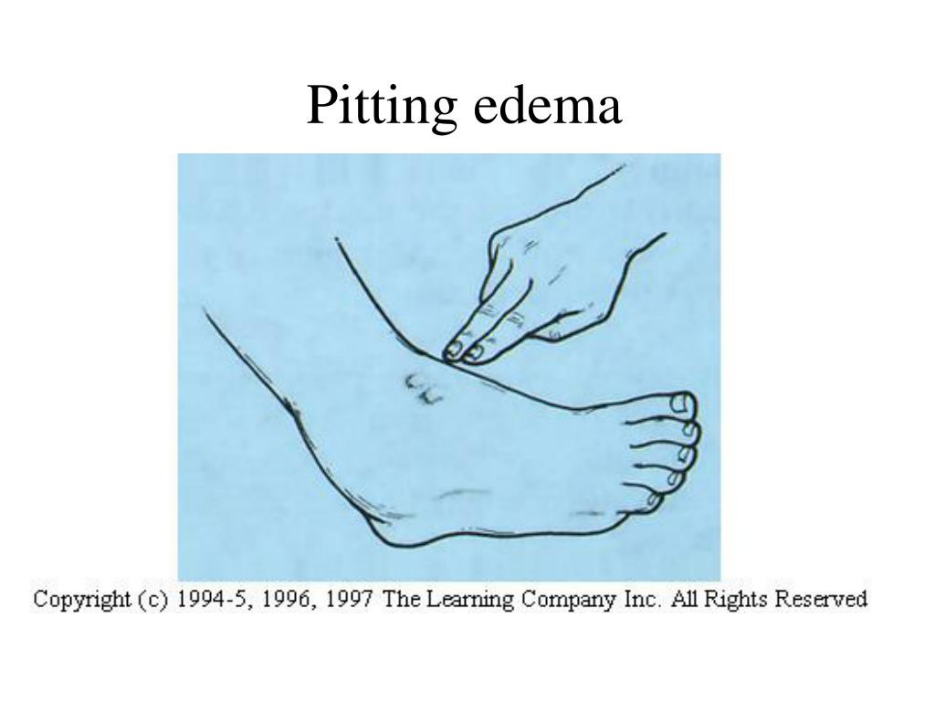In which disease process should a nurse expect to see a patient with the presence of pitting edema?
Diabetes mellitus
Liver disease
End-stage renal disease
Colon cancer
The Correct Answer is B
Choice A reason:
Diabetes mellitus is not typically associated with pitting edema unless it has led to a comorbid condition such as heart failure or kidney disease. Pitting edema is more commonly associated with fluid retention due to the body's inability to manage fluid balance, which is not a direct consequence of diabetes mellitus itself.
Choice B reason:
Liver disease, particularly cirrhosis, can lead to pitting edema. The liver's inability to produce albumin, a protein that helps maintain oncotic pressure in the blood vessels, and portal hypertension, which is an increase in the blood pressure within the portal vein system, can both contribute to the development of pitting edema.
Choice C reason:
End-stage renal disease can also cause pitting edema due to the kidneys' inability to excrete excess fluid. However, the edema associated with renal disease is often more generalized and not limited to the lower extremities.
Choice D reason:
Colon cancer is not typically associated with pitting edema unless it has metastasized and caused secondary complications that affect the liver or the heart. Pitting edema is not a direct symptom of colon cancer itself. 
Nursing Test Bank
Naxlex Comprehensive Predictor Exams
Related Questions
Correct Answer is C
Explanation
Choice A Reason:
While falls are a common cause of injury in children, they are not the leading cause of TBI in adolescents. Falls tend to be more frequent in the younger population, particularly in children under the age of 4. In adolescents, sports-related injuries and motor vehicle accidents are more prevalent causes of TBI.
Choice B Reason:
The statement that females have twice the risk of TBI compared to males is incorrect. National data reveal that males are at increased risk of TBI compared to females, especially in the adolescent age group. This is likely due to higher engagement in risk-taking behaviors and contact sports.
Choice C Reason:
Concussions in sports and motor vehicle accidents are indeed the leading causes of TBI in adolescents. Engaging in contact sports such as football, hockey, and soccer can lead to concussions, which are a form of mild TBI. Motor vehicle accidents are also a significant risk factor due to high-impact collisions that can cause head injuries.
Choice D Reason:
Firearm incidents are a serious concern for TBI; however, they are not the most common cause of TBI in adolescents. While firearm-related injuries can be severe and are a leading cause of TBI-related deaths, concussions from sports and motor vehicle accidents account for a larger number of non-fatal TBIs in this age group.
Correct Answer is C
Explanation
Choice A Reason:
The facial nerve, or cranial nerve VII, is responsible for the taste sensation in the anterior two-thirds of the tongue, not the posterior third. It carries taste sensations from the front part of the tongue via the chorda tympani branch.
Choice B Reason:
The abducens nerve, or cranial nerve VI, has no role in taste sensation. It is primarily involved in controlling the lateral rectus muscle of the eye, which abducts the eye.
Choice C Reason:
The glossopharyngeal nerve, or cranial nerve IX, provides special sensory innervation for taste to the posterior third of the tongue. This enables the sensation of various tastes like salty, sweet, sour, and bitter in this region.
Choice D Reason:
The hypoglossal nerve, or cranial nerve XII, is responsible for motor control of the tongue muscles but does not provide sensory innervation for taste.
Whether you are a student looking to ace your exams or a practicing nurse seeking to enhance your expertise , our nursing education contents will empower you with the confidence and competence to make a difference in the lives of patients and become a respected leader in the healthcare field.
Visit Naxlex, invest in your future and unlock endless possibilities with our unparalleled nursing education contents today
Report Wrong Answer on the Current Question
Do you disagree with the answer? If yes, what is your expected answer? Explain.
Kindly be descriptive with the issue you are facing.
